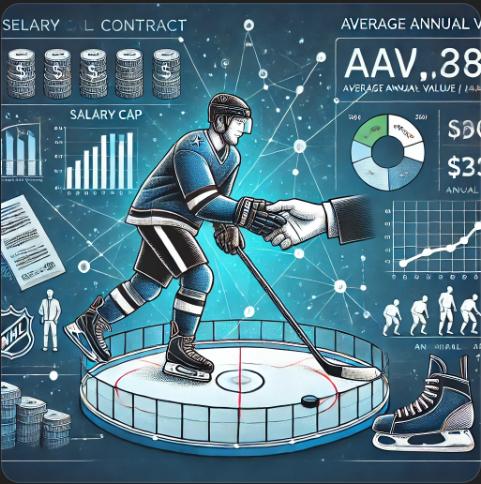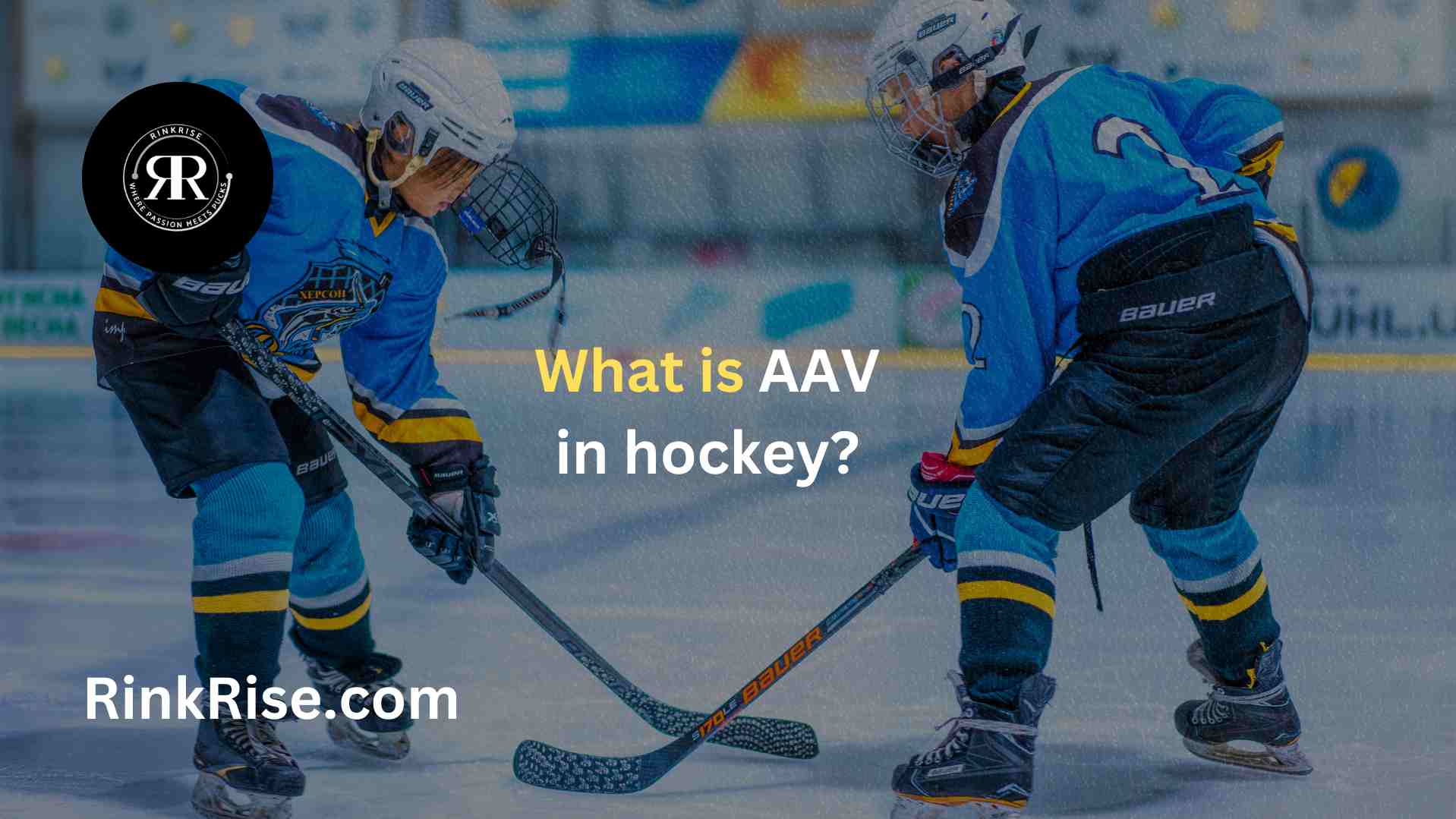Understanding AAV in Hockey
(Average Annual Value) AAV in hockey is a term used to describe the average yearly amount of a player’s contract. It is not directly related to a player’s performance statistics but instead concerns their salary. To calculate AAV, you divide the total contract value by the term of the contract. This figure is then used to determine how much of the team’s salary cap the player occupies.
Calculation of AAV
To find the AAV of a player’s contract, you take the complete value of the contract and divide it by its duration. Contracts in the NHL can range from 1 to 8 years. For instance, a player with a three-year contract worth $15 million would have an AAV of $5 million per year. Similarly, a contract of $25 million over six years equates to an AAV of approximately $4.17 million annually.
It’s important to note that the AAV doesn’t necessarily reflect the actual yearly payment to the player but represents an average over the life of the contract.
Significance of AAV in NHL Salary Regulations
Average Annual Value (AAV) is crucial because it determines how a player’s salary impacts the team’s salary cap in the NHL. This cap system ensures that teams adhere to fair spending limits set by the league.
Role of AAV Under NHL Guidelines
The NHL and the NHL Players’ Association (NHLPA) have established a collective bargaining agreement that dictates the financial framework of the league, including revenue sharing, which is split approximately 50/50 between players and owners. Part of this agreement specifies a salary cap, which includes both a minimum and a maximum limit that teams must respect when allocating salaries.
For example, during the 2019-2020 season, the salary cap floor was set at $60.2 million, with a ceiling of $81.5 million. Teams must manage their finances to stay within these boundaries, and AAV plays a key role in this process.
The league calculates a team’s total expenditure on salaries by summing the AAVs of all contracts for the active roster, typically consisting of 22 to 23 players who compete in the NHL, excluding those in minor leagues. If a team’s combined AAVs surpass the salary cap, they must adjust by trading players, placing them on waivers, or reassigning them to minor league affiliates.

Understanding the Impact of AAV on NHL Team Budgets
Average Annual Value (AAV) is essential in the NHL as it determines the impact of a player’s salary on a team’s salary cap. This system helps maintain balanced spending across the league.
How AAV Influences Team Budgets in the NHL
The NHL, along with the NHL Players’ Association (NHLPA), has a collective bargaining agreement that outlines the league’s financial operations, including a system where revenues are nearly evenly divided between players and owners. This agreement also sets a salary cap, which dictates both the minimum and maximum amounts teams can spend on player salaries.
During the 2019-2020 season, the salary cap limits were defined with a floor of $60.2 million and a ceiling of $81.5 million. Teams are required to manage their payroll to stay within these limits, and AAV is crucial for this management.
The league assesses whether teams are within the salary cap by adding up the AAVs of all contracts for the active roster, which includes 22 to 23 NHL players, excluding minor league players. If a team exceeds the salary cap due to their total AAVs, they must make adjustments, such as trading players, placing them on waivers, or sending them to the minors to comply with the cap limits.
Leveraging AAV for Salary Cap Management
Average Annual Value (AAV) is a strategic tool in the NHL, used not just for meeting salary cap limits but also for ensuring teams reach the minimum payroll, known as the salary floor.

Utilizing AAV in Team Rebuilding Strategies
During a rebuild, teams often focus on nurturing young talent, aiming for long-term success similar to the models previously successful in Pittsburgh and Chicago. Achieving the salary floor can be challenging when the roster is filled with lower-cost young players and journeymen. One common strategy to meet this floor without inflating actual payroll is through acquiring high-AAV contracts that are nearing their end and have most of their financial obligations already paid.
For instance, the Arizona Coyotes have executed several trades to assume high-AAV contracts with minimal actual salary due. A notable example involved acquiring Niklas Grossman and the injured Chris Pronger, whose contract had an AAV of $5 million but only $750K was due in real salary, from Philadelphia in exchange for Sam Gagner and a fourth-round pick. This type of transaction allows teams to align with salary cap regulations economically.
Key Considerations with AAV
- Salary Cap Impact: AAV directly affects how much a player’s contract counts against the team’s salary cap, crucial for managing team finances effectively.
- Contract Structures: It’s particularly vital in long-term and front-loaded contracts, where AAV smooths out the cap hit across the contract duration, despite actual salaries fluctuating.
- AAV vs. Actual Salary: The AAV may differ from the actual salary paid in any given year, especially with contracts that vary annually or include bonuses.
- Contract Negotiations: AAV is also a critical factor during free agency and contract renewals, influencing a player’s market value and negotiating leverage.
Understanding and manipulating AAV allows NHL teams to strategically manage their salary cap while planning for both current and future team dynamics.
Read Also: What is GAA in Hockey Statistics?
Conclusion
In essence, the Average Annual Value (AAV) is crucial for financial management within the NHL, ensuring teams stay within the prescribed salary cap limits. By distributing a player’s total contract value evenly over its duration, AAV directly affects team budgeting strategies, aiding in both maintaining financial equilibrium and guiding strategic decisions for future team growth.
FAQ’s: AAV in hockey
What does AAV stand for in hockey?
AAV refers to the average annual value of a player’s contract. It represents the total value of the contract, including salary, signing bonuses, and any earned performance bonuses, divided by the duration of the contract in years. This calculation is used to determine a player’s cap hit.
What is the function of AAV in hockey?
AAV, or average annual value, is used to calculate how much a player’s contract contributes annually towards the team’s salary cap. This helps in managing the team’s total budget effectively.
How does AAV influence team roster management in hockey?
AAV, or average annual value, impacts roster decisions by dictating how much of the team’s salary cap is allocated to a single player. A higher AAV can limit the team’s flexibility to sign or keep other players.
Can a player’s AAV vary during the contract period in hockey?
No, the average annual value (AAV) stays the same for the duration of the contract. It is determined at the time of signing based on the total contract value.
How does AAV influence trades in hockey?
AAV, or average annual value, is crucial in trades because it affects how a player’s salary impacts the team’s salary cap. Teams must consider this when acquiring players to ensure they remain within budget limits.
Does a player’s AAV change when they move to a different team?
No, the average annual value (AAV) remains consistent across different teams. It is fixed based on the player’s contract terms.
What are the penalties for surpassing the salary cap in hockey?
Yes, if a team exceeds the salary cap, they may be penalized with fines, loss of draft picks, or the cancellation of contracts.




Hey! Do you know if they make any plugins to assist with SEO?
I’m trying to get my website to rank for some targeted keywords
but I’m not seeing very good success. If you know of any please share.
Appreciate it! I saw similar article here: Eco bij